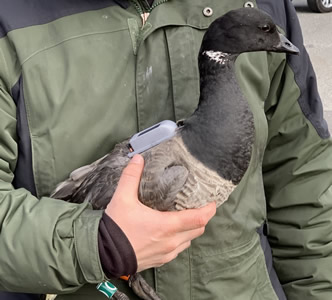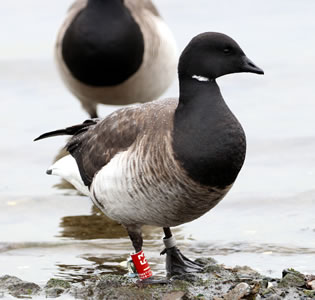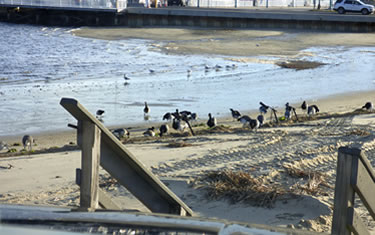
 Official Site of The State of New Jersey
Official Site of The State of New JerseyVideos:
2020 Spring Migration
2020 Full Annual Cycle Migration
Pour voir cette page web en français, cliquez ici.
New Jersey Fish and Wildlife is participating in a multi-year Atlantic brant migration and breeding ecology studies collaborating with the New York Department of Environmental Conservation, Canadian Wildlife Service, and University of Missouri, School of Natural Resources.
Atlantic brant are a small goose species that breeds in arctic Canada and winters in the Mid-Atlantic region of the United States. About 90% of the entire population winters along the coast of New Jersey and New York.
During the past three years, nearly 2,500 brant have been tagged with three different types of auxiliary markers in addition to “standard” metal leg bands. Please note that all brant with auxiliary markers will also have a standard metal band. Help from the public reporting these encounters is critical to the success of this project. You may encounter these four types of markers:
1. Backpack transmitters. Some birds carry these units (Figure 1). Note that many, but not all, brant with backpack transmitters may also be wearing colored leg bands.
2. Colored leg band with geolocator. The geolocators are clear, plastic electronics devices about the size of a “fat nickel” and are attached to a red and white plastic leg band with a plastic cable lock tie (Figure 2). Geolocators gather light data, have a 5-year life, and reveal two important pieces of brant ecology. First, geolocators are only put on females, and “signatures” in the data reveal whether a given female attempted (or not) to breed in a given year. Second, geolocators also provide coarse location data through the full annual cycle.
If you shoot or find a dead brant with a backpack transmitter or geolocator: Please contact Ted Nichols at 609-628-3218 or by e-mail ted.nichols@dep.nj.gov to return the device(s). If undamaged, transmitters can be reused on future study birds. Unlike a transmitter, geolocators do not transmit a signal or beacon but rather store their data internally. In order to obtain any previous location data from a geolocator, we need to get the device in hand and download the data to a computer. To facilitate retrieving the geolocator, Fish and Wildlife will send hunters a self-addressed, stamped, padded envelope to return the device. Hunters who want to retain a geolocator or transmitter as a “keepsake” will be given the unit back or provided with a “dummy” unit.
If you see a live brant with a red and white band and geolocator: These bands are red with white and have 3 codes; the first code is a letter, followed by 2 numbers. Please report these observations to US Bird Banding Lab at REPORTBAND.GOV.
3. Colored plastic leg bands. Nearly 1,700 brant have been marked with various colored bands with black, white, or yellow letters and numbers with only one letter or number on each band (Figure 3). Bands have many different colors. These birds have one band on each leg. Bands on each leg may be the same or different colors.
If you shoot or find a dead brant with a colored marker, please report it to the US Bird Banding Lab at REPORTBAND.GOV.
If you see a live brant with a colored leg band: Note that there is one band on each leg and it is critical in the report that you differentiate which marker color and code is on which leg (right or left). Please report these observations to US Bird Banding Lab at REPORTBAND.GOV.
4. “Standard” metal leg band. Brant with “standard” metal leg bands that are shot or found dead should be reported to US Bird Banding Lab at REPORTBAND.GOV. On the rare occasion that these codes can be read on live birds, they can also be reported to the Lab.
Band “Targeting” by Waterfowl Hunters
A very small proportion of waterfowl are marked with bands in North America. As such, standard leg bands and especially auxiliary markers (for example, tarsal banded brant) are often viewed as “trophies” by waterfowl hunters and are sometimes sought as unique “targets” rather than just harvesting the first birds that come into the decoys in a given day. Although the bands used in this study are generally small and difficult to see in a hunting situation, hunters are urged to not specifically “target” Atlantic brant marked in this study.
For a better understanding of the band “targeting” issue, and how it can affect waterfowl management, please check out Episode 34 – Band Reporting and Band Targeting, by Dr. Mark Lindberg at the University of Alaska on Ducks Unlimited web site: www.ducks.org/media/du-podcast



Study Objectives
These studies are deploying these various markers on both the wintering grounds in New Jersey and New York as well as the breeding grounds in Nunavut, Canada. Marked birds will provide insight into the following Atlantic brant research questions:
We appreciate the cooperation and interest from the public.

